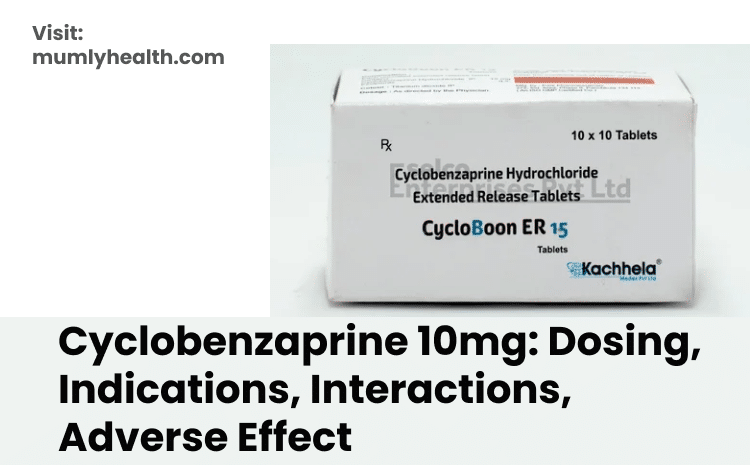cyclobenzaprine (marketed as Flexeril) operates is not fully understood. However, it helps alleviate stiffness, pain, and discomfort resulting from muscle sprains, strains, or injuries. It is also sometimes used off-label to address pain associated with fibromyalgia.
Cyclobenzaprine may also be identified by its previous trade name, Flexeril, although there are generic and alternative brands available.
The usual time it takes for cyclobenzaprine to start working is approximately one hour after ingestion, leading to muscle relaxation and relief from spasms. This medication is available in both immediate-release and extended-release formulations.
If you are prescribed cyclobenzaprine, it is important to follow your healthcare provider’s instructions regarding its usage.
Typical Cyclobenzaprine Side Effects
- Blurred vision
- Dryness in the mouth
- Sensation of lightheadedness
- Dizziness
Moreover, there is a possibility of severe adverse effects associated with cyclobenzaprine, such as seizures, irregular heart rhythms, heart attacks, or strokes. These incidents are more likely to occur when an individual has an excessive amount of cyclobenzaprine in their system. This could happen, for instance, due to an overly high prescription dosage or misuse of the medication.
Since there is insufficient evidence supporting the effectiveness of cyclobenzaprine for long-term use, and considering that the muscle spasms it treats are typically of short duration, prescriptions generally do not exceed two to three weeks. However, in cases of cyclobenzaprine abuse, an individual might continue using it for an extended period and potentially increase the dose to dangerous levels, leading to risky side effects and potential overdose.
Interactions of Cyclobenzaprine with Other Substances: Cyclobenzaprine can enhance the effects of central nervous system depressants, such as alcohol, opioids, allergy medications, and sleep aids. It can also interact with other drugs.
Individuals prescribed cyclobenzaprine should inform their healthcare provider about all medications they are taking (including non-prescription drugs) and whether they consume alcohol or other substances.
This allows the provider to assess potential interactions and ensure the patient’s safety. Even after the perceived effects of cyclobenzaprine have worn off, the drug may still remain in the body, leading to serious interactions with other substances.
Cyclobenzaprine (Flexural) Detoxification & Withdrawal: When individuals abruptly stop using cyclobenzaprine after prolonged use, some have reported experiencing withdrawal symptoms. These may include:
- Nausea
- Headaches
- Generalized discomfort
Addressing Cyclobenzaprine (Flexeril) Misuse at Laguna Treatment
Although there is an ongoing debate regarding the addictive potential of cyclobenzaprine, individuals who exhibit problematic usage patterns may benefit from addiction treatment. This is especially relevant if someone has been concurrently using cyclobenzaprine along with other substances.
Laguna Treatment Hospital, located in Orange County, CA, provides a comprehensive rehabilitation facility that utilizes established, evidence-based approaches throughout different phases of addiction treatment. These treatment stages include:
- Medical detoxification.
- Inpatient residential treatment.
- Planning for ongoing care post-treatment.
What does an expiration date mean?
An expiration date indicates the final day on which the manufacturer guarantees the optimal potency and safety of a medication. This information can be found on the packaging of most medications, including prescription drugs, over-the-counter (OTC) products, and dietary supplements.
How are drug expiration dates determined?
The expiration date of a medication is determined through stability testing conducted in accordance with the guidelines of good manufacturing practices as outlined by the Food and Drug Administration (FDA). Drugs intended for the US market typically have an expiration date ranging from 12 to 60 months from the date of manufacture.
However, once the original container is opened, whether by a patient or a healthcare provider dispensing the drug, the initial expiration date on the container can no longer be considered reliable. Despite this, stability studies have shown that the actual shelf life of a drug might be longer than initially stated.
In pharmacies, you often see “beyond-use” dates indicated on prescription bottle labels given to patients. These dates may include instructions like “do not use after…” or “discard after…” and are mandated by many state Boards of Pharmacy. These dates typically extend to one year from the date of prescription fill. But why do these expiration dates sometimes differ?
From the manufacturer’s perspective, a drug’s stability cannot be guaranteed once its original container is opened. Various storage conditions, such as exposure to heat, humidity, and light, can affect the drug’s stability.
Retail and hospital pharmacies, as well as nursing homes and consumers, dispose of billions of dollars worth of medications annually based on the printed expiration dates on stock bottles.
Read Also: 8mg Suboxone Round Orange Pill
Factors Impacting the Duration of Cyclobenzaprine Effects
Several factors can affect the duration of cyclobenzaprine’s effects. To understand how long the drug’s impact lasts in your system and affects your body, it’s important to consider these factors. The duration of cyclobenzaprine’s effects can be influenced by the following:
- Prescribed Dosage: The duration of cyclobenzaprine’s effects may depend on the dosage recommended by your physician. Effects from a higher dose might last longer than those from a lower dose.
- Metabolic Rate: The rate at which your body metabolizes and eliminates cyclobenzaprine varies among individuals due to differences in metabolic rates. Your response duration to the medication might be affected by your metabolic rate.
- Liver Involvement: Cyclobenzaprine’s primary metabolic process occurs in the liver. Liver disease or damage can potentially alter the drug’s duration in the body and its lasting effects.
- Interaction with Other Medications: Concurrent use of other drugs can influence the duration of cyclobenzaprine’s effects. Medications that inhibit or induce specific liver enzymes might impact cyclobenzaprine’s metabolism, thus affecting how long it remains active.
- Individual Responses: Responses to cyclobenzaprine can vary from person to person. Factors such as overall health, weight, and sensitivity to the drug can contribute to variations in how long the drug’s effects persist.
If you have any questions or concerns about the duration of cyclobenzaprine’s effects, it’s important to communicate with your doctor. They can provide personalized guidance based on your specific circumstances.
